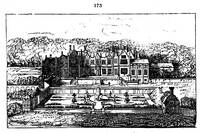558. During the reign of James I. (1603 to 1625), the gardens of Theobalds and Greenwich were formed or improved. The garden at Theobalds, Mandelso, a traveller who visited England about 1640, describes as 'a large square, having all its walls covered with phillyrea, and a beautiful jet d'eau in the centre. The parterre hath many pleasant walks, part of which are planted on the sides with espaliers, and others arched over. Some of the trees are limes and elms, and at the end is a small mount, called the Mount of Venus, which is placed in the midst of a labyrinth, and is upon the whole one of the most beautiful spots in the world.' (Voyages de Mandelso, tom. i. p. 598.) The same author, speaking of the garden of St. James's Palace, says ' il n'est pas fort grand, et n'a rien de remarquable, si ce n'est qu'au milieu on voit dans une grande pierre carre et creuse au milieu cent dix-sept quadrans. Il est accompagne d'un verger d'arbres fruitiers plantes en echiquier, ayant au milieu un gros piller de bois qui jette de l'eau, et d'un petit bois qui forme quelques allees assez agreables, et qui nourrit quelques cerfs daims et chevreuils.' The garden of the queen's palace in St. James's Park, he describes as having, 'une grotte, faite de tous sortes des esquillages (what in modern times would be called a rockwork of shells), representant le Parnasse, en sorte neanmoins que l'ete elle ne laisse pas de pousser toutes sortes de fleurs et d'herbes, qui font un tres-bel effet. La veritable grotte est du cote du palais, d'ou on voit Apollon et les Muses, et sur la haut de la montagne un Pegase de bronze dore. Au pied on trouve quatre petites voutes, qui couvrent autant des statues de marbre, tenant chacune une corne d'abondance, et sous le bras une cruche dont elles versent de l'eau dans un basin qui baigne le pied de la montagne. L'une de ces statues qui est de marbre noir represente la Tamise, et se fait connoitre par un distique Latin.' (Mandelso's Voyages and Travels, &c., folio edit. 1719, tom. ii. p. 751.) Lord Bacon attempted to reform the national taste during this reign, but apparently with little immediate success. He wished still to retain shorn trees and hedges; but proposed winter or evergreen gardens, and rude or neglected spots, as specimens of wild nature. 'As for the making of knots or figures,' says he, 'with divers-coloured earths: they be but toys. I do not like images cut out in juniper or other garden-stuff: they are for children.' (Essay on Gardens.) Sir Henry Wotton says, 'the garden at Lord Verulam's was one of the best he had seen, either at home or abroad.' Oxneed Hall (fig. 173.) is a fine specimen of a nobleman's scat in this age.

